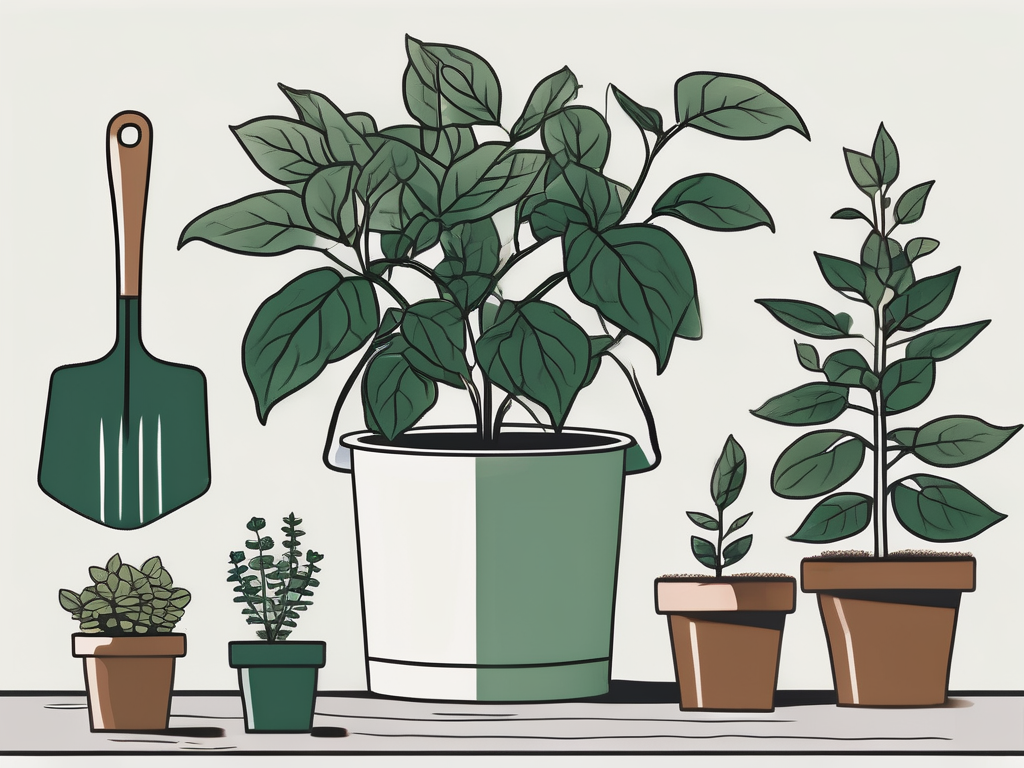
Hypoestes, often known as the polka dot plant, is a delightful and colorful addition to any indoor garden. With its vibrant foliage, it can brighten up any corner of your home. But what if you want more of these charming plants without spending extra money at the nursery? The good news is that propagating Hypoestes is as easy as pie, and today, we'll walk you through the process step-by-step.
In this article, we'll cover everything you need to know to propagate your Hypoestes successfully. From choosing the right time to propagate, to the materials you'll need, and the actual steps of propagation, you'll have all the information necessary to grow your polka dot plant family. Let's get started!
Understanding When to Propagate Hypoestes
Timing can be everything when it comes to plant propagation. With Hypoestes, the best time to propagate is during its growing season, which typically stretches from spring to early summer. This is when the plant is most vigorous and more likely to produce new roots and leaves quickly.
Why not propagate in the off-season? Well, during the colder months, plants generally go into a sort of dormancy to conserve energy. Attempting to propagate during this time means your cuttings might struggle to root. The plant’s energy reserves are lower, making it less likely to bounce back and flourish.
That said, if you notice your Hypoestes looking a bit leggy or sparse, it might be a sign that it’s time for a trim and propagation. Cutting back your plant encourages bushier growth, and those cuttings can be your new plant babies!
Gathering Your Materials
Before you start snipping away, you’ll need to gather a few materials. Fortunately, propagating Hypoestes doesn’t require anything too fancy. Here’s what you’ll need:
- Sharp, clean scissors or pruning shears: Clean cuts help prevent disease and infection.
- Small pots or containers: These will be home to your new plants as they root.
- Potting soil: A light, well-draining mix is ideal.
- Rooting hormone (optional): While not necessary, it can speed up the rooting process.
- Water: A spray bottle or watering can to keep the soil moist.
- Plastic bags or a propagation dome: These help retain humidity around the cuttings.
Having everything ready before you begin makes the process smoother and more enjoyable. Plus, it gives you a great excuse to indulge in some plant-related retail therapy if you're missing any items!
Taking the Cuttings
Now that you've got your materials, it's time to take some cuttings. Look for healthy, non-flowering stems on your Hypoestes. Ideally, each cutting should be about 4 to 6 inches long with at least a couple of leaves.
Follow these steps to take your cuttings:
- Prepare your scissors: Sterilize them with rubbing alcohol to prevent transferring any diseases to your cuttings.
- Select your stems: Choose vibrant, healthy stems. Avoid any that look diseased or damaged.
- Make the cut: Snip just below a node (the point where the leaf joins the stem), as this is where new roots will emerge.
- Remove lower leaves: Strip away the leaves from the bottom half of the cutting. This helps prevent rot and focuses the plant's energy on root development.
Taking cuttings can feel a bit like giving your plant a haircut. Don’t worry—both your existing plant and the cuttings will benefit in the long run!
Rooting the Cuttings
Once you have your cuttings, you can root them either in water or directly in soil. Both methods have their pros and cons, and the choice often depends on personal preference.
Rooting in Water
- Place the cuttings in a jar of water: Ensure only the stem is submerged—not the leaves.
- Change the water every few days: This keeps it fresh and prevents stagnation.
- Wait for roots to form: You should see roots in about 2-3 weeks.
Water rooting is great because you can watch the roots develop, which is quite satisfying. Plus, it’s easier to monitor for any signs of trouble.
Rooting in Soil
- Dip the cuttings in rooting hormone: This step is optional but can boost success rates.
- Plant the cuttings in moist potting soil: Ensure they're planted deep enough to stay upright.
- Cover with a plastic bag or dome: This traps humidity, creating a mini greenhouse effect.
- Keep the soil moist: Avoid letting it dry out completely.
Rooting directly in soil helps cuttings transition more easily to their permanent homes, as they’re already used to a soil environment.
Caring for Your New Plants
Once your cuttings have rooted, they’ll need a little TLC to grow into strong, healthy plants. Whether you rooted them in water or soil, the next steps are crucial.
If you started in water, transfer the cuttings to soil once the roots are about 1-2 inches long. When planting, be gentle to avoid damaging those delicate new roots. Here's how to care for your young plants:
- Light: Place them in bright, indirect light to encourage growth without scorching the leaves.
- Watering: Keep the soil consistently moist but not waterlogged. Hypoestes prefers slightly humid conditions.
- Humidity: If your home is dry, consider using a small humidifier or misting the plant regularly.
- Fertilizer: Once the plant is established, feed with a balanced liquid fertilizer every 4-6 weeks during the growing season.
Seeing your new plants thrive is one of the most rewarding parts of propagation. Before you know it, you'll have a vibrant collection of polka dot plants to enjoy or share with friends!
Common Issues and Troubleshooting
Even with the best care, sometimes things can go a bit sideways. Here are some common issues you might encounter and how to handle them:
Cuttings Not Rooting
If your cuttings aren’t rooting, try these tips:
- Check the light: Ensure they're getting enough indirect light.
- Monitor humidity: Low humidity can hinder root development, so consider using a humidity dome.
- Inspect for rot: Discard any cuttings that have turned mushy or discolored.
Wilting or Yellowing Leaves
If your cuttings or young plants are wilting or yellowing, consider the following:
- Check the watering: Ensure the soil is moist but not soggy.
- Evaluate lighting conditions: Adjust their position if they’re getting too much or too little light.
- Inspect for pests: Look for signs of aphids or other insects, and treat accordingly.
Remember, propagation is often a process of trial and error. With patience and a bit of practice, you'll learn what works best for your Hypoestes.
Expanding Your Plant Collection
Once you've mastered propagating Hypoestes, you might find yourself eager to try your hand with other plants. Many houseplants can be propagated with similar techniques, including pothos, spider plants, and succulents.
Consider swapping cuttings with friends or joining a plant swap group in your area. It's a fantastic way to expand your collection without breaking the bank, and you might just make some new plant-loving friends along the way!
Plus, sharing plants is a wonderful way to spread joy and greenery. Who wouldn't love a gift of a vibrant, polka-dotted plant to brighten their day?
Incorporating Hypoestes into Your Home Decor
Once you've got a thriving collection of Hypoestes, it's time to think about how to incorporate them into your home decor. Their bright foliage can add a pop of color to any space, and their compact size makes them versatile for various settings.
Here are a few ideas:
- Windowsills: Hypoestes love bright, indirect light, so a sunny windowsill can be a perfect spot.
- Terrariums: Due to their small size, these plants are great for terrariums, adding a splash of color among ferns and moss.
- Mixed plant displays: Pair them with other small plants in a planter for a mini indoor garden.
Experiment with different placements and arrangements to see what looks best. Hypoestes can adapt to a variety of settings, so have fun with it!
Sharing the Love
One of the joys of propagating plants is sharing them with others. Whether it's gifting a rooted cutting to a friend or participating in a plant swap, sharing plants can create connections and spread joy.
Consider labeling your cuttings with care instructions to help new plant parents succeed. It's a small touch that can make a big difference in their plant's health and longevity.
Sharing your knowledge and plants can also inspire others to start their own plant journey. Who knows? You might just be the catalyst for someone else's newfound love of houseplants!
Final Thoughts
Propagating Hypoestes is a fun and rewarding way to expand your plant collection. With a little patience and attention, you'll be able to create beautiful new plants to enjoy or share with others. Remember, each cutting is a chance to learn and grow as a plant parent.
At Cafe Planta, we love helping plant lovers like you nurture and care for their green companions. If you have any questions, don't hesitate to email us or send a message via Instagram. We're here to support you on your plant journey and offer a variety of plants, accessories, and plant-themed apparel to help you create a thriving indoor garden.












